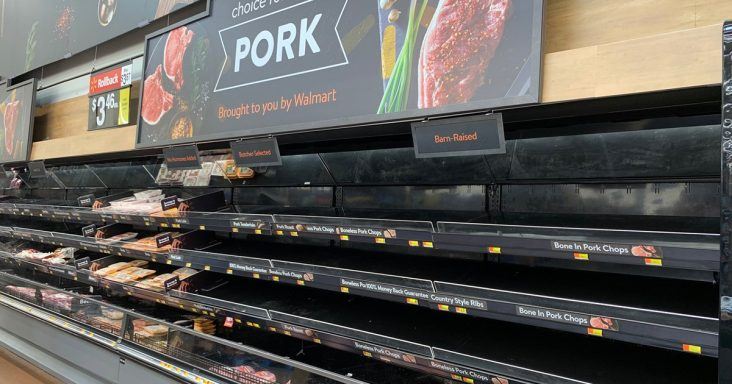China buys more U.S. pork; beef packing capacity improves
by May 11, 2020 4:39 pm 2,735 views

Pork meat cases at a Walmart Supercenter in Jane, Mo are mostly empty as the retail giant has issues getting and keeping pork items in stock.
While U.S. pork slaughter and processing facilities have been hit hard from the COVID-19 spread and running at roughly 40% capacity for the past few weeks, China booked more than 40,200 metric tons of pork from the U.S. during the week of April 24–30.
That was the largest order from China since October 2019, according to the U.S. Department of Agriculture. Net pork exports overall were down 12% from a year ago.
The U.S. pork industry had been expecting an uptick in pork exports to China, but agricultural economists say it couldn’t come at a more difficult time given national meat production was off about 30% to end April.
Widespread temporary plant closures across the U.S pork and beef packing industry from the COVID-19 outbreaks have been well documented. Pork processors from Tyson Foods to Smithfield and Hormel have experienced temporary plant closures and extended employee absenteeism in the past few weeks, causing temporary shortfalls in the supplies going to retail customers.
Pork has been the hardest meat protein for grocery retailers to get and meat cases are more often empty and purchase limits have been placed on products when they are in stock.
The Iowa Farm Bureau Federation (IFBF) reported the state’s weekly pork production was down 44%, or nearly 1.3 million head, for the week ending May 2, which is the lowest weekly hog slaughter in the past decade. Similarly, Iowa cattle production was down 38%.
The bottleneck in the supply chain, coupled with a growing number of market-ready hogs, has depressed prices to the point where many pork farmers face significant losses in 2020 and beyond, continuing an eight-year economic downtown for Iowa farmers, according to the IFBF.
Sam Funk, a senior economist at the IFBF, said just two months ago hog market inventories were at their record high
“U.S. and Iowa pork farmers went into this pandemic producing at record levels to meet consumer needs, but the shortened capacity to harvest pigs due to COVID-19 resulted in an excess supply of pigs, despite very strong demand for pork protein from the U.S. and global consumers,” Funk said.
He said thousands of hogs are unable to be processed due to the bottleneck in the supply chain caused by COVID-19 issues. Funk expects consumers will see short-term impacts at the grocery stores it selects and quantities available for purchase. He said Iowa farmers face immense challenges that are likely to extend throughout this year into 2021.
BEEF PRODUCTION
Beef production has also been impacted sharply since early April. Derrell Peel, livestock marketing specialist at Oklahoma State University, said cattle slaughter has decreased an average 27% over the past five weeks, compared to a year ago. He said as late as March cattle slaughter had been up 5.5% before the COVID-19 impact began. Peel said recently cattle slaughter was about 452,000 head, down about 32.2% from a year ago, but up 6.4% from the prior week, which provided a glimmer of hope packing plants are increasing capacity.
“This hopefully indicates the beginning of a recovery of packing capacity in the coming weeks. Risks remain, however, and it is not clear how fast meatpacking plant capacity will recover. New safety measures and work protocols likely mean that effective maximum capacity in beef packing plants will be reduced compared to pre-COVID-19 levels,” Peel said.
Peel expects it will take many weeks for slaughter rates to catch up with the growing backlog of fed cattle and getting the industry current. Meantime, he said all sectors of the industry are responding to the need to slow cattle down and hold them longer in a variety of production settings before proceeding to finish in feedlots.
Peel said beef production was down nearly 690 million pounds in the five weeks ending May 9. He said production is down by about 30% but looks to have hit a bottom two weeks ago.
Beef exports reported by USDA were down 12% for the week ending April 30. China was one of the countries that increased purchases of U.S. beef at 1,400 metric tons. Peel said exports are good for U.S. cattle and hog producers because they increase the overall value per head.
Tyson Foods CEO Noel White said recently meat production is expected to be higher in 2020 than in 2019. He said the temporary gaps in processing capacity will be rectified in the coming weeks as restaurants come back online and more consumers return to work with higher safety precautions in place.
